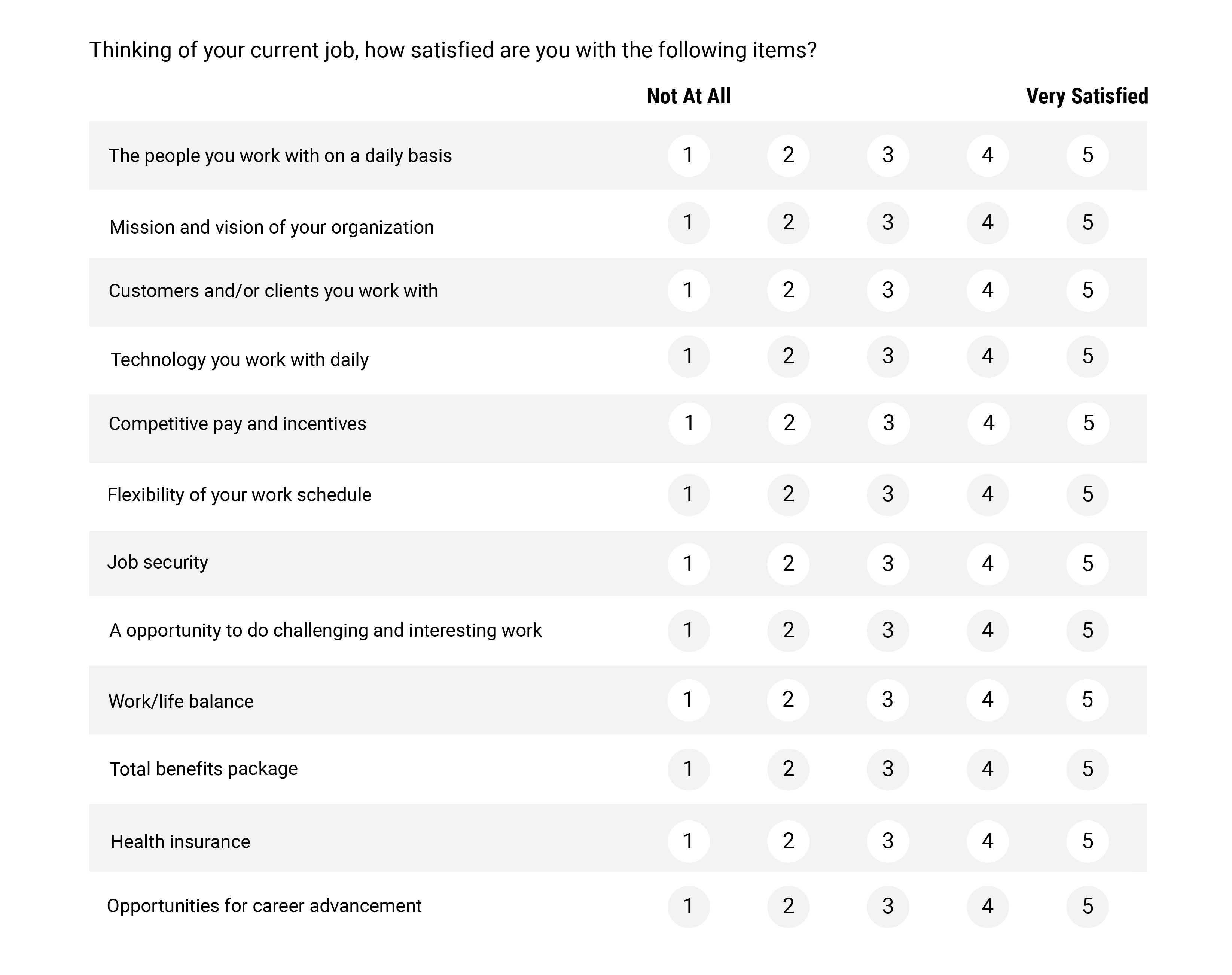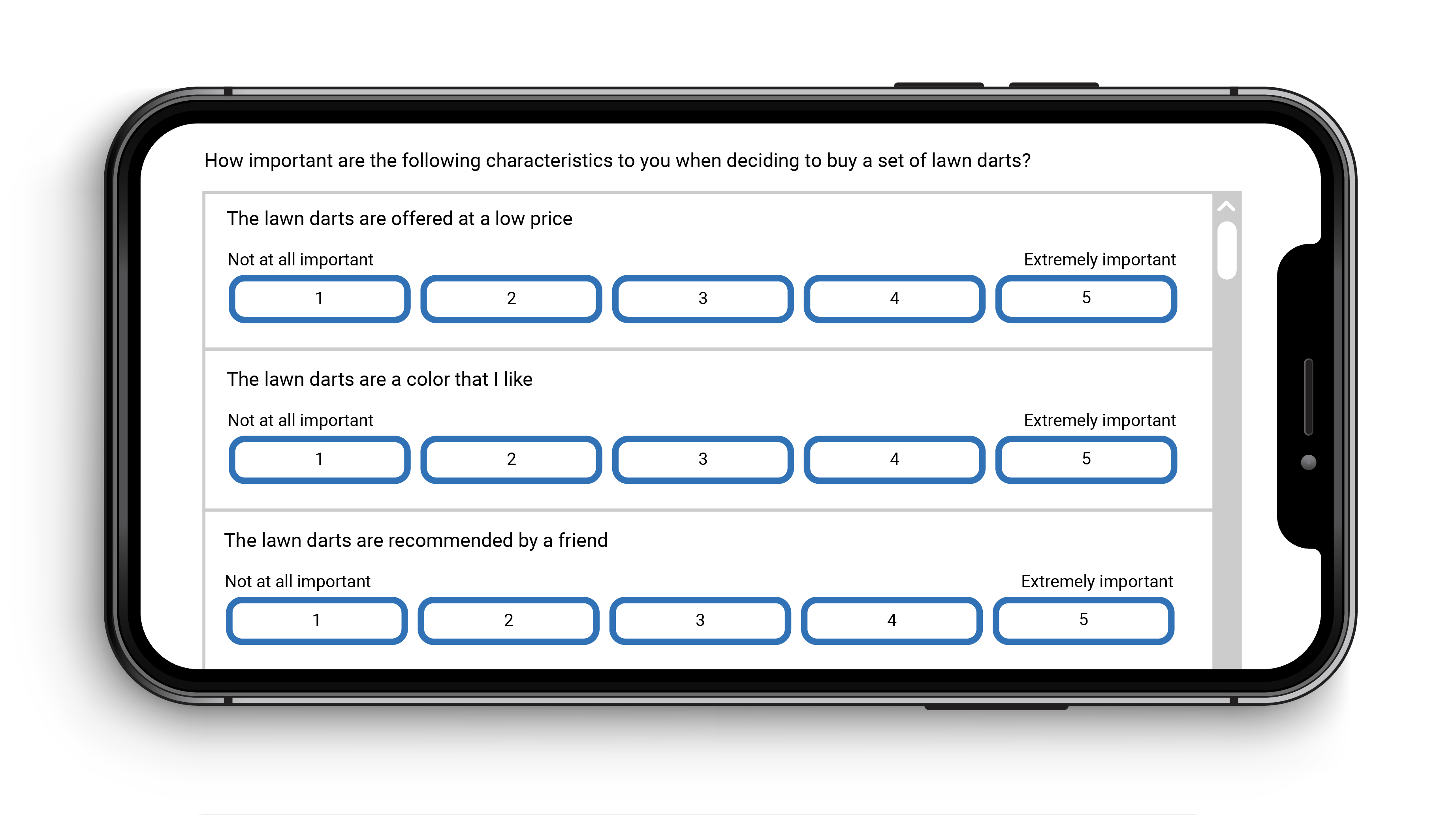Including quality control questions when designing your survey questionnaire is an important step...
Matrix questions in survey data collection feature a group of multiple-choice questions presented in a grid of rows and columns. These types of questions simplify the survey creation process for researchers because they are easy to program and bundle questions together in a way that makes it easier for respondents to answer.
Respondents find them easier to interpret and answer because the answer choices and responses remain the same across all the questions. However, overusing matrix questions can lead to certain pitfalls. Relying too heavily on matrix questions can encourage poor survey-taking habits among respondents, like straight-lining. Read on to learn more about the advantages and disadvantages of using matrix questions in surveys.
What Are Matrix Questions?
In a survey, a matrix question groups single-answer and multiple-choice questions together and displays them in a grid of rows and columns. Matrices are also referred to as table questions, grid questions, or question batteries. These names are often used interchangeably because they allow survey authors to combine several question types in one table.
Matrix questions present questions to survey takers with predefined answer choices that apply to each question. In many matrix questions, you’ll notice that the answer choices are a type of scale.
When Should You Use Matrix Questions?
Matrix questions are appropriate to use when a survey author wants respondents to rate a group of similar attributes. For example, the survey author can display the feature of a product in rows, and the satisfaction rating for each could be the columns.
In this scenario, the respondent can quickly and effectively give feedback on various features of a product using the same scale to measure satisfaction. Matrix questions simplify surveys by making questions of this nature easier to answer and flow more efficiently.

Types of Matrix Questions
Depending on their research needs, survey authors have three different types of matrix questions to choose from. The three types of matrix questions are single-selection, multiple-selection, and multiple-matrices. Read on to learn more about each type of matrix question.
Single-selection: In a single-selection matrix, each question allows one answer selection. These questions are the most similar to standard multiple-choice questions.
Multiple-selection: Multiple-selection matrix questions are also similar to multiple-choice questions, except each question allows the user to select more than one answer choice.
Multiple-matrices: Matrix questions that feature multiple matrices allow researchers to mark answers as exclusive in a table. Respondents can select a specific scale point to answer a statement, while the others remain deselected. This format allows scale points to have answers that are exclusive only to specific statements.
Writing Effective Matrix Questions
There are a few crucial factors to consider when writing matrix questions for your survey. Many of the best practices for creating an effective survey also apply to this questioning approach. In any survey, matrix questions should be easy for respondents to understand and follow, no matter what device they are using. Smartphone and mobile device users are working with less screen space, so optimizing your mobile surveys and matrix questions is crucial.
Matrix questions help simplify surveys by bundling multiple single-answer and multiple-choice questions together. If you find that the questions you are trying to bundle together make less sense in a tabled format, you might need to explore other methods.
Here are a few tips to keep in mind when designing and optimizing matrix questions for your survey:
- Scales should be consistent throughout the survey with positive to negative or low number to high number.
- Keep response options and columns of possible responses short and sweet. Try to limit your survey to displaying five or fewer responses at a time.
- Be mindful of the grid size. For mobile users, you should only use a maximum of six columns.
- To prevent respondent fatigue, consider the number of statements per battery. Generally, you should limit it to 20 statements per battery. If more statements are required, split them into two batteries with other question types in between.
- Avoid repeat matrices as they tend to be cumbersome to respondents and may lead to data quality issues.
- Randomization of rows is standard in survey design, but should not be forgotten.
- Keep in mind that horizontal formatting of matrix questions isn’t ideal for smartphones.

Advantages of Matrix Questions
Matrix questions help survey authors streamline the survey-taking experience for respondents. The primary advantages of matrix questions include saving space, reducing drop-off, and making question-and-answer sets easy to understand.
Since matrix questions are a series of questions presented as a single table, they can help authors save space on the screen or paper. Freeing up real estate on a survey can help reduce respondent fatigue by making the questionnaire appear less cumbersome. Splitting a matrix question into numerous single-answer or multiple-choice questions that are repetitive may dissuade users from completing your survey, resulting in more drop-off.
Many respondents find the grids and tables of matrix questions intuitive and easy to follow. This format excels at presenting close-ended, predefined answer sets in a way that’s digestible and easy to complete. Afterward, survey authors and researchers can create an easy-to-analyze data set after collecting all the results from deploying this question format.
Disadvantages of Matrix Questions
Although it can be helpful to deploy matrix questions in many research projects and surveys, there are a few things to consider before using them. While matrix questions can help streamline many similar multiple-choice questions into a more digestible format, matrices that are too cumbersome and time-consuming can cause participants to disengage and encourage poor survey-taking. For example, too many choices might cause respondents to lose interest and enter random answers to finish it.
Matrix questions are risky because they must be deployed correctly for full efficacy. Using too many rows or columns can negatively impact the data quality by making it difficult to complete or confusing to look at. For mobile users, matrix questions might not be viable options because they can be challenging to display properly on smaller screens.
How Matrix Questions Differ From the Likert Scale
Some survey authors believe that matrix questions mimic the Likert scale when it is the other way around. In fact, Likert scales are a specific type of matrix question. Likert scale questions measure opinions linearly using a five or seven-point scale to collect the respondents’ sentiments about a product or service. On many surveys, matrix questions often happen to be Likert scales but can also be applied to use cases that aren’t attitudinal measurements.
If you’re thinking about deploying a survey with a Likert scale or questions in a similar format, it is imperative that you follow a few best practices:
- Clearly define anchors; in scales, the positive end should always get the highest number, with statements in the affirmative.
- Decide at the beginning of your survey design if you want to allow an undecided response. Even scales force a slide, while uneven scales allow users to select an undecided middle option.
- Include a maximum of six columns to ensure that mobile users can view the entire question and all of the answer choices.
How IntelliSurvey Can Help
IntelliSurvey can help create cross-consideration and cross-purchase matrices for clients to assess peer sets for particular competitors. For example, what percent of their target customers are considering purchasing from another brand or retailer?
By asking consumers about their experiences with key brands and retailers within an industry, we can help clients understand who their customers are considering purchasing from and compare their brands against other competitors in the field.
IntelliSurvey has a variety of products and services to help companies create an effective survey that employs matrix questions. With help from IntelliSurvey, your organization can better understand consumer sentiments toward your products or services.
If you’re interested in working together, please contact us for more information.




